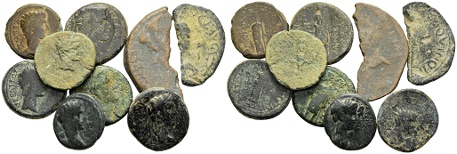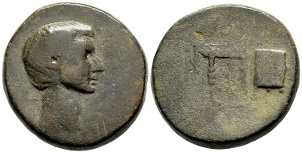Fine Coins Showcase
Antiquities Showcase
Show Empty Categories
Shop Search
Shopping Cart
My FORVM
Contact Us
About Forum
Shopping at Forum
Our Guarantee
Payment Options
Shipping Options & Fees
Privacy & Security
Forum Staff
Selling Your Coins
Identifying Your Coin
FAQs
zoom.asp
Home ▸ Catalog ▸ |Greek Coins| ▸ |Greek Imperial| ▸ |Asia Minor & Cyprus||View Options:   | | | | | | |


In "An intriguing new coin from Mallus, Cilicia" (2008), Jyrki Muona, based on a high grade specimen with an excellent portrait, identified the head on this type as Otho. He noted the portrait is influenced by the style of the Antioch mint. Indeed the portrait on that specimen looks very much like the portraits of Otho from Antioch. RPC I attributes the type to Nero but notes, "The portrait does not look much like Nero, but the date seems clear. Could it possibly be a coin of Galba?" We are following RPC I, listing it as Nero, but noting the other possibilities.RP112383. Bronze AE 25, RPC Online I 4024 (3 spec.), SNG Levante 1269, aVF, dark green patina with traces of red, cleaning scratches, minor flan flaws on rev. edge, weight 9.678 g, maximum diameter 25.4 mm, die axis 0o, Mallus (near Karatas, Turkey) mint, 67 - 68 A.D.; obverse ...CEBACTOC..., laureate head right; reverse MAΛΛΩTΩN, Athena Magarsis standing facing, spear vertical in right hand, star above each arm, EΛP (year 135) outer left; ex CNG e-auction 538 (10 May 2023), lot 413; very rare;
Lot of 9 Julio-Claudian Roman Provincial Bronze Coins, c. 20 B.C. - 54 A.D.


The following list was provided by the consignor and has not been verified by FORVM:
1) Augustus, Caius and Lucius, AE28, Julia Traducta, Spain, cut half of a RPC I 107.
2) Claudius (41-54), AE18, Aezanis, Phrygia, Pausanius Menandros, magistrate, Zeus standing left, RPC I 3095 or similar.
3) Augustus, AE18, RPC I 2399, patina flaking at rim.
4) Caligula, AE18, Nero and Drusus jugate, AE18, Philadelphia, Lydia.
5) Tiberius, AE19 (2.95g) Ephesos, no legend, head of Tiberius right / facing statue of Artemis Ephesia, RPC I 2613.
6) Time of Tiberius, AE20, Tripolis, Lydia, RPC I 3055.
7) Augustus or Tiberius, AE20, Laodicea ad Lycus, Phrygia, bare head right / Zeus standing left
8) Claudius, AE20, Aezanis, Phrygia, RPC I 3095.
9) Tiberius, with Nero and Drusus, cut half Æ As of Carthago Nova, Spain, 14 - 37 A.D.
LT112798. Bronze Lot, lot of 9 Julio-Claudian Roman provincial bronze coins, 2 are cut halves, 17.2mm - 31.1mm, mostly F - VF, two are cut halves, c. 20 B.C. - 54 A.D.; no tags or flips, the actual coins in the photograph, as-is, no returns, 9 coins;
Marcus Aurelius, 7 March 161 - 17 March 180 A.D., Mostene, Lydia


Mostene, in ancient Lydia, prospered in Roman and Byzantine eras. There is debate, based on a line in Tacitus, over whether Mostene was a Macedonian colony or a native Lydian city. In 17 A.D. the city was hit by an earthquake and was assisted by relief from Tiberius.RP113182. Bronze AE 35, Apparently unpublished; GRPC Lydia -, RPC Online IV -, F, dark green patina, earthen deposits, marks, pit lower right, weight 21.592 g, maximum diameter 35.3 mm, die axis 180o, Mostene (Kepecik, Turkey) mint, c. 161 - 162 A.D.; obverse AVT K M AVPH ANTΩNEINOC, laureate, draped, and cuirassed bust right, seen from behind; reverse EΠI AΛEΞANΔPOY APX ΛYΔ MOCTHNΩN (authority of Alexandros, archon, Mostene), Demeter, holding grain and torch?; from the Michael Arslan Collection, ex Solidus auction 123 (25 Jul 2023), lot 359 (part of); the only known specimen; extremely rare;
Gordian III, 29 July 238 - 25 February 244 A.D., Antiocheia, Pisidia


ME113244. Bronze AE 33, Krzyzanowska XI/58; RPC Online VII.2 2730; BMC Pisidia p. 194; 104; SNGvA 4952; SNG BnF 1199; SNG Hunter 2130; McClean 8945; SNG Pfalz 84, Choice VF, well centered, small central dimples, light deposits, light marks, weight 25.898 g, maximum diameter 33.3 mm, die axis 180o, Antioch in Pisidia (Yalvac, Turkey) mint, 29 Jul 238 - 25 Feb 244 A.D.; obverse IMP CAES M ANT GORDIANVS AV-G (Imperator Caesar Marcus Antonius Gordianus Augustus), laureate, draped, and cuirassed bust right; reverse CAES ANTIOCH COL (Caesarea Antiochia Colonia), she-wolf standing right under fig-tree suckling the twins, Romulus and Remus, S R in exergue;
Nero, 13 October 54 - 9 June 68 A.D., Koinon of Galatia, Galatia


In 25 B.C., Augustus raised Ankara to the status of a polis and made it the capital city of the Roman province of Galatia. Ankara is famous for the Monumentum Ancyranum (Temple of Augustus and Rome) which contains the official record of the Acts of Augustus, known as the Res Gestae Divi Augusti, an inscription cut in marble on the walls of this temple. An estimated 200,000 people lived in Ancyra in good times during the Roman Empire, a far greater number than was to be the case from after the fall of the Roman Empire until the early 20th century.
Numismatic scholars have long speculated which city in Galatia was the minter of the Koinon of Galatia issues, with reasons to suggest Ancyra, Pessinus, and Tavium. In May 2023, a member of the FORVM Ancient Coins Discussion Board asked for help in identifying a Roman provincial of Galba with a temple reverse that he believed was a product of Tavium. Quite surprisingly, its actual origin was Ancyra and its strong resemblance to RPC I 3566, a Koinon of Galatia issue struck under Galba, was unmistakable. The Ancyra coin, still unpublished on RPC Online and the earliest attested Roman provincial issue of the city, also bore an owl countermark (Howgego 468). This mark was previously known only from the Koinon of Galatia coinages of Nero and Galba, thus adding even more evidence in favor of Ancyra as the Koinon minter/issuer.RP114405. Bronze AE 20, RPC Online 3563A (6 spec., otherwise apparently unpublished) , VF, green patina, smooth surfaces except for the occasional tiny pit, a handsome specimen, weight 4.577 g, maximum diameter 20.3 mm, die axis 0o, Ancyra (Ankara, Turkey) mint, 13 October 54 - 9 June 68 A.D.; obverse NEPΩNOΣ ΣEBAΣTOY, laureate head right; reverse ΣEBAΣTH, Nike striding left, wreath in extended right hand, palm frond in left hand; very rare;
Augustus, 16 January 27 B.C. - 19 August 14 A.D., Uncertain Mint, Anatolia or Syria


The mint, the quaestor who struck this type, and even the identity of the person in the portrait remain uncertain. The type has previously been attributed to Macedonia and the portrait identified as Brutus (Friedlander) or Caesar (Grant). David Sear notes the type has never been found in Macedonia. Finds point to Syria or Anatolia. It is possible that the type was issued, with his own portrait, by Sosius, a general under Marc Antony who was quaestor in 39 B.C. Much more likely, however, the portrait is of Augustus.RP111713. Bronze AE 27, RPC I 5409; Sear CRI 957 (Syria); AMNG III 226, pl. III, 6; FITA 13, F, dark green patina, weight 18.142 g, maximum diameter 27.4 mm, die axis 0o, uncertain Anatolian or Syrian mint, c. 39 B.C.(?); obverse bare head right; reverse hasta (spear), sella quaestoria (quaestor's seat of office), and fiscus (imperial treasury), Q (quaestor) below; previously a rare type but recent finds have made it easier to acquire;
Julia Mamaea, Augusta, 222 – 235 A.D., Nicomedia, Bithynia


The referenced coin, RPC Online VI T3432 = Rec Gén 334, is the only known specimen of this type and RPC notes, "Tooled, likely not belonging to Nicomedia." The present coin confirms attribution to Nicomedia. Furthermore, this type for Julia Mamaea nicely complements the Severus Alexander issue with the same reverse (RPC Online VI T3435). RP113006. Bronze assarion, RPC Online VI T3432 corr. (legends), Rec Gén 334 corr. (same), F, green patina, weight 3.540 g, maximum diameter 18.4 mm, die axis 210o, Nicomedia (Izmit, Turkey) mint, group 1b, 222 – 235 A.D.; obverse IOVΛIA MΑMAIA CEBAC, draped bust right; reverse NIKOMHΔEΩN ΔIC NEΩKOPΩN, veiled and draped bust of Demeter right, wearing stephane, stalks of grain before her; 2nd known and the best of the type known to FORVM; extremely rare!;
Hierapolis, Phrygia, c. 244 - 249 A.D., Homonoia with Sardis


This type is dated to the reign of Philip I based on this coin's reverse die which is shared with a coin of Otacilia Severa. The Π on the reverse abbreviates ΠYΘIAN, referring to the Pythian games, which were, after the Olympian, the greatest in importance of the four chief Hellenic festivals. The X abbreviates XPYΣANΘINA, referring to games held near Hierapolis on the banks Chrysoroas river. RP114890. Bronze AE 24, RPC Online VIII U63168 (15 spec., this coin cited), Franke-Nollé 872, SNG Tüb 4050, Weber 7122, Johnston Hierapolis -, SNG Cop -, VF, near centered on a tight flan, weight 5.931 g, maximum diameter 24.0 mm, die axis 180o, Phrygia, Hierapolis (near Pamukkale, Turkey) mint, pseudo-autonomous, c. 244 - 249 A.D.; obverse IEPA CY-NKΛHTO-C, draped bust of the senate right; reverse IEPAΠOΛEITΩN K CAPΔIANΩN NEΩKOPΩN OMONOIA, two wreaths, containing letters Π and X; ex Rex Numismatics budget auction 4 (15 Dec 2023), lot 400;
Caracalla, 28 January 198 - 8 April 217 A.D., Hadrianopolis-Sebaste, Phrygia


Coins of Hadrianopolis-Sebaste in Phrygia are relatively scarce and their somewhat barbaric-looking busts and poorly engraved legends can usually help to distinguish its coins from the better engraved coins of Hadrianopolis, Thrace. Also note, Hadrianopolis-Sebaste is not the same city as Sebaste, Phrygia. -- www.wildwinds.comRP114417. Bronze AE 23, RPC V.2 (to be published; 3 spec. incl. this coin), cf. Waddington 6065 (Sept. Sev.; same rev. die), Lindgren III 589 (same) corr. (Commodus), Choice F, barbaric style, good centering, green patina, minor encrustations, weight 5.204 g, maximum diameter 23.4 mm, die axis 180o, Hadrianopolis-Sebaste (near Doganhisar, Turkey) mint, c. 198-211 A.D., Mnesitheos, son of Hieron (magis); obverse M AY?AN-T℧NEINOC (NEI ligate), laureate, draped, and cuirassed bust right, seen from behind; reverse CEB? AΔPIANOΠ-O EΠI?MNHC IEPO? (NH ligate), Tyche-Fortuna standing facing, head left, kalathos on head, in right hand rudder on globe, cornucopia in left; added to the (still in progress) RPC V.2 database!; very rare ;
Severus Alexander and Julia Maesa, 222 - 235 A.D., Ninica-Claudiopolis, Cilicia


Ammianus mentions Silifke and Claudiopolis as cities of Cilicia, or of the country drained by the Calycadnus; and Claudiopolis was a colony of Claudius Caesar. It is described by Theophanes of Byzantium as situated in a plain between the two Taurus Mountains, a description which exactly, corresponds to the position of the basin of the Calycadnus. Claudiopolis may therefore be represented by Mut, which is higher up the valley than Seleucia, and near the junction of the northern and western branches of the Calycadnus. It is also the place to which the pass over the northern Taurus leads from Laranda. The city received the Roman colony name Colonia Iulia Felix Augusta Ninica.RB91011. Bronze AE 36, cf. asiaminorcoins.com 6551 (same obv. die & c/m), SNG Levante -, RPC Online -, SNG BnF -, SNG Cop -, BMC Cilicia -, c/m: Howgego 262, F, weak legends, porosity, edge cracks, weight 17.901 g, maximum diameter 35.8 mm, die axis 180o, Ninica-Claudiopolis (Mut, Mersin, Turkey) mint, 222 - 235 A.D.; obverse IMP C SEVERUS ALEXANΔER AVΓ (or similar), laureate, draped, and cuirassed bust right, seen from behind; c/m: Nike right in c. 5 x 8 mm oval punch (3 times); reverse IVL MAECA COL IVL FEL NINIO CLAUΔIOPOLI (or similar), draped bust of Julia Maesa right; huge 35.8 mm!; ex Forum (2015); extremely rare;
CLICK HERE TO SEE MORE FROM THIS CATEGORY - FORVM's PRIOR SALES



Page created in 1.906 seconds.









